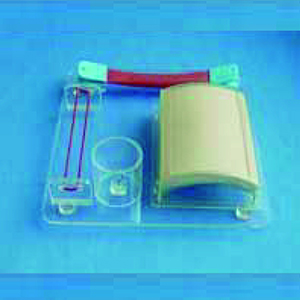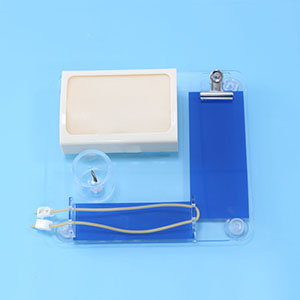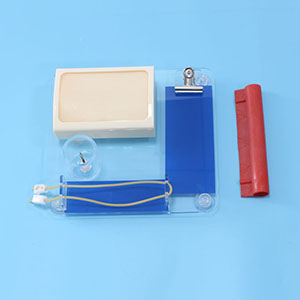Welcome to visitShanghai Chinon medical Model & Equipment Manufacturing Co., LTD
In medical education, the development of surgical skills has always been the most challenging part of the learning process. As a basic and key technique in surgery, surgical suture is the only way for medical students to enter clinical practice. However, how to help students master this complex skill in a short time and apply it efficiently in the clinic has always been a difficult problem in the field of medical education. In recent years, surgical suture packaging display models, as an innovative training tool, have been favored by more and more medical education institutions. So, can the use of surgical suture packaging to display models effectively shorten the clinical skills training cycle? This article will combine market trends, industry experts' opinions and relevant data for in-depth analysis.
Innovative design of surgical suture packaging display model

Surgical suture Packaging Display model
The Surgical Suture Packaging Display model is a training tool that simulates human tissue, usually made of highly simulated materials, capable of simulating different layers such as skin, fat, and muscle. It is designed to help students practice suture operations repeatedly in a safe and controlled environment, improving their surgical proficiency and clinical resilience.
The core advantages of this model are its high degree of simulation, repeatable training, and real-time operational feedback. Through the model, students can learn how to control the needle and thread, adjust the depth and Angle of the suture, and can feel the touch of real surgery. This allows students to practice extensively and gradually improve their skill level without worrying about patient safety.
Market trend: Widespread use of simulation technology
With the continuous development of medical education, simulation technology has gradually become an important part of medical training. According to a study in the journal of Technology in Medical Education, simulation training can effectively improve the skill level and operational confidence of medical students. The study also showed that repeated practice with simulated devices resulted in lower rates of operational errors and higher success rates for students in real clinical Settings.
Specific to surgical suture training, more and more educational institutions and hospitals on the market began to use surgical suture packaging display model for teaching. According to the 2019 Global Medical Simulation Market report, the use of simulation training in medical education has reached about 35%, and this proportion is expected to continue to grow to 50% in the next five years. This trend indicates that simulation training tools are gradually replacing the traditional teaching mode and becoming the mainstream way of medical education.
Expert opinion: Improve training efficiency, shorten the learning cycle

Many industry experts believe that the surgical suture packaging demonstration model can greatly shorten the cycle of clinical skills training. By providing opportunities for repeated training, students can master basic operational skills in a shorter period of time without having to rely on limited clinical practice opportunities.
For example, a study by a medical training organization showed that after two weeks of intensive training using a surgical suture packaging demonstration model, participants improved their operational success by 20% and were more confident in completing suture tasks in a simulated environment. Experts pointed out that model training can not only accelerate the speed of students to master the technology, but also reduce the clinical errors caused by improper operation, so as to improve the teaching effect and the practical operation ability of students.
According to another survey published by the American Medical Education Association (AMA), 75% of healthcare organizations said that the use of simulation training equipment has enabled new healthcare personnel to reduce their reliance on mentors and significantly shorten the learning curve when entering clinical practice.
Data support: Comparison between model training and traditional training

A comparative study of the effectiveness of surgical suture training showed that students using surgical suture packaging display models had a higher success rate on real patients than students under traditional training methods. The data showed that after two weeks of model training, the success rate of sutures increased by 28% and the failure rate decreased by 15%. Compared with traditional theory explanation and classroom demonstration, simulation training significantly improves the students' proficiency and adaptability in practical operation.
In addition, repeated training on the model will not only enable students to better master the basic skills, but also familiarize themselves with complex stitching techniques in a short time. Studies have shown that after model training, participants' learning cycles are reduced by about 25%, which means they are able to enter clinical practice earlier and have higher confidence in the operation.
Conclusion: Surgical suture packaging demonstrates the future prospects of the model
Based on the above analysis, it is obvious that the surgical suture packaging display model can play a great role in medical education, especially in shortening the clinical skills training cycle. Through highly simulated training, students not only gain more effective skill upgrading, but also gain experience in a safe environment and reduce clinical errors. With the continuous progress of simulation technology, it is expected that this training method will play a greater role in future medical education, helping more medical students to master core surgical skills in a shorter period of time, and laying a solid foundation for future medical practice.
Through this model, the efficiency of medical education will be greatly improved, and the operational skills of students will be rapidly improved. As industry experts say, "Simulation training is an important development direction of medical education in the future, which can not only shorten the training period, but also improve clinical safety."
|
NEXTпјљWhy is the advanced infant head venipentesis training model a concern?
LASTпјљHow can I improve my clinical skills through anatomical models of upper limb muscles? |
Return list |